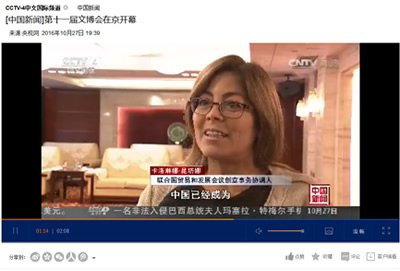UNCTAD participated at The China Beijing International Cultural and Creative Industry Expo (ICCIE) hosted by the Ministry of Culture, State Administration of Press, Publication, Radio, Film and Television and the People's Government of Beijing, China was held from 27-30 October in Beijing.
The forum focused on the integration and optimization of cultural and creative industry resources, promote cultural and creative industry projects and trade, and contribute to the transformation and upgrading of cultural and creative sectors.
Madame Vice Mayor Chen Hong highlighted that China 13th Five Year Plan (2016-20) aims to find new drivers of growth by promoting innovation and entrepreneurship.
The Plan states that China should "promote the transformation and upgrading of publishing, film and television, arts and crafts and other traditional industries". New information technology will be supported by the government as a strategic emerging industry which is key for the development of the cultural and creative industries.
Mr. Li Wei, stated that Cultural and Creative Industries (CCIs) are pillars of Beijing economy. Beijing is pushing forward the development of CCI's which account for 13.8 per cent of Beijing GDP.
Mr. Yu Qun from the Ministry of Culture said CCI's are growing rapidly accounting for 3.9 % of China GDP. They are assuming an increasingly important role in the transformation of the economy, adding new energy, reshaping the modernization and structure of the economy for a better living in China. The cultural sectors embrace the cultural symbols of China, the Chinese tea, the historic sites, films, music and traditions.
UNCTAD, cross-border cooperation in East, South-East and South Asia has great potential as their economies are still growing at a rate close to 5 per cent. The Asian region is among the most dynamic markets in international trade of CCIs, with creative goods exports at $243 billion in 2015. The Regional Comprehensive Economic Partnership represents 3.4 billion people, a large share of youth, with high levels of connectivity and a large consumer base, makes the region a promising market for the CCIs development, for cross-border trade and investment and for the development of soft innovation.
Tuo Zuhai, in a world of digitalization, science and technology will help to create more value and boundless opportunities for the CCI's. The platform of animation of games and cartoons can help to better represent China's image and to showcase China's cultural and natural richness.
Tarun Sawney, 39 per cent of the software used in the world is not licensed and this is affecting also the CCIs market. There is an increasing need to protect data.
Wu Wenhui, from Internet Reading Online, the site has 10 million works, 4 million writers, 600 million clients. These are feeding movies and TV series which have become hits in the market. The system has an established IP system to ensure innovation.
Zhang Yu, emphasized the importance of the Silk Road Initiative to boost multilateral cooperation in arts and performances. China staged many cultural performances worldwide (3,000) in 2015 with over 2,300 artists from different municipalities. Chinese soap operas will be staged at Lincoln Center in New York. This year is the China-Latin America cultural exchange with many activities planned.
Dialogue 1: Integrated Development of the Cultural Industry with Science, Technology and Finance
The discussion focused on the changing landscapes in the media (film, TV, Music, Print, Advertising, Radio, etc) and ICTs sector transforming society and economic structures and industries. It is important that public and private actors that invest in the creative industries sectors understand the overall industrial structure. More funding is needed to support the creative industries potential.
Dialogue 2: New Opportunities for Cultural Industrial Parks in the IP Era
The Chinese Culture and Media Industry Investment Report say China had more than 3,000 theme entertainments parks last year. However, only 10% are profitable. Domestic parks lack brand appeal, and in addition it needs stronger Chinese elements to be more attractive culturally. IP frameworks for developers, creators, users and distributors are key for the sustainability of the industry. Many people are not familiar with the IP instruments, copy rights and market value.
UNCTAD also participated in the annual International Forum on the Development of Animation and Games Industry. The forum gathers Government officials, CEOs and influential entrepreneurs from the animation and games industries to reflect the achievement and performance of these industries. China's cartoon and animation industry stands at $15.7 billion in 2014, with annual growth rate of 17.17 percent. The forum concluded with a vsit to the Expo exhibitions of cultural goods and services with exhibitions from art and crafts to, audiovisuals products, cultural relics and museum related creative products and creative industry cluster zone exhibitions.
Up to 103 creative activities, 114 special sessions were organized with exhibitions from art and crafts to, audiovisuals products, cultural relics and museum related creative products, Creative Industry cluster zone exhibitions, Huali Award -China Innovation Competition, Youth Creative Design Contest, etc.



